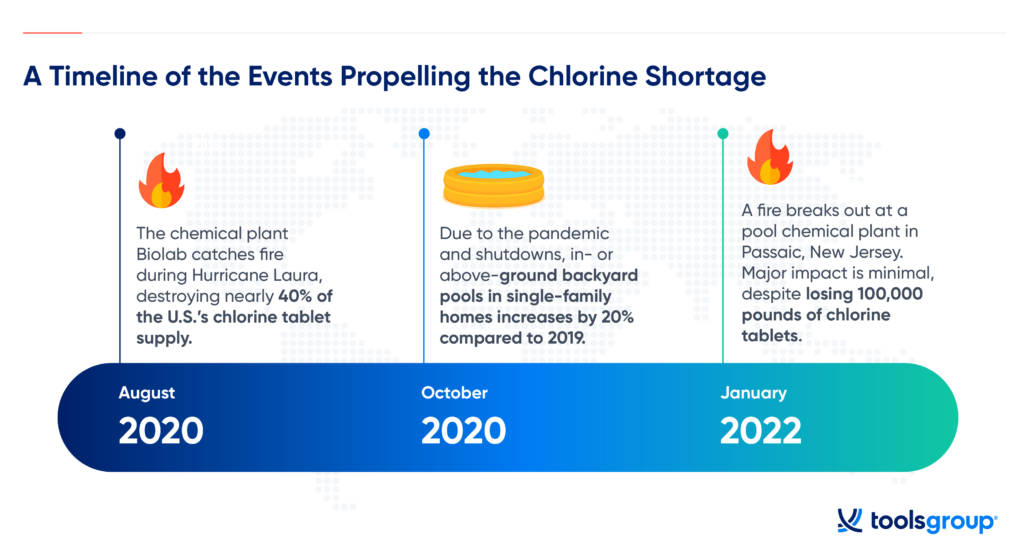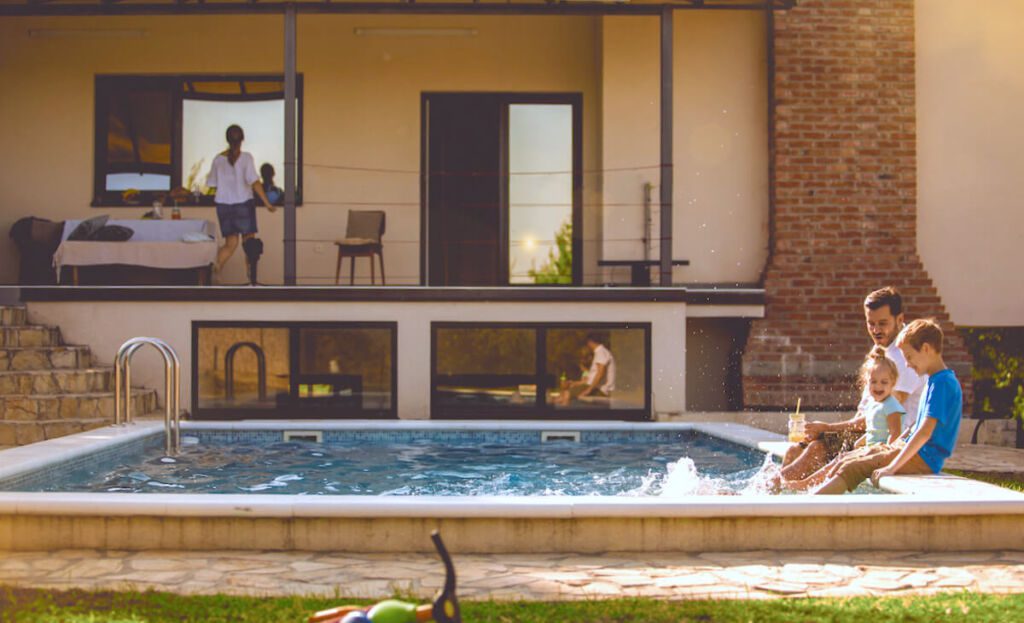Coming Up Short During the Chlorine Shortage For Swimming Pools in 2022
Everyone loves a sequel. Continuing the original story with new challenges and successes. While the second year of the chlorine shortage might not have a warm welcome, pool and spa owners can still have a happy ending to this sequel.
While we are approaching a new summer in 2022, pool and spa owners can expect the same chlorine shortage that plagued the industry last summer in 2021. Chlorine tablets and liquid chlorine prices have continued to rise and exceed last summer’s prices.
So, what does that mean for your pool or spa this summer? While you can continue to hunt down and overpay for traditional chlorine methods, we recommend taking a smarter approach to successfully swimming this summer.
Here’s how to get your pool or spa care on the winning side of this chlorine shortage sequel.
Chlorine Shortage 2022: How We Got Here
Why is there a pool chlorine shortage?
In August 2020, the chlorine shortage arose when Hurricane Laura struck the largest trichlor chemical plant in Louisiana. From 2019 to 2020, construction of new pool builds went up 20 percent – causing chlorine demand to soar. In January 2022, another chemical plant caught fire in Passaic, New Jersey. While the New Jersey fire wasn’t as detrimental as the one in Louisiana, it still resulted in the losing 100,000 pounds of chlorine tablets. On top of the fires, the pandemic left pool owners spending more time at home in their pools than ever before. As a result of the growing demand from 2020 to now, pool chlorine will continue to diminish in supply in 2022.



How long will the pool chlorine shortage last?
The damaged chlorine manufacturing plant in Louisiana is currently being rebuilt and was set to reopen in late 2022, but ongoing construction material shortages could cause a delay. In March 2022, the chlorine manufacturing plant realistically projected that the new facility’s chlorine production would officially start again in 2023.
How much do pool chlorine tablets cost in 2022?
With supply chain constraints and the ongoing chlorine shortage, you can expect a 58 percent increase in chlorine prices compared to last year, according to a Goldman Sachs report. Prior to the chlorine shortage, a typical 50-pound bucket of chlorine tablets would have cost $75 to $85. In 2022, that same 50-pound bucket of chlorine tablets will cost you around $250 – resulting in around a 212.5 percent chlorine tablet price increase in 2022.
Should you start stocking up on overpriced chlorine tablets? Probably not. Properly stored chlorine tablets have a 3-year shelf life. So, trying to hunt down and hoard overpriced chlorine tablets could just be a waste of your time and money.
What should you do about the pool chlorine shortage?
If you’re looking for the best long-term chlorine shortage solution, follow the recommendation of pool and spa professionals across the United States and Canada and consider investing in a chlorine alternative. For pool owners who are health-conscious or have a busy schedule, it’s not a matter of if they’ll get a chlorine alternative pool sanitizer but when.
The key is finding the right chlorine alternative for your home pool or spa – so you aren’t stuck paying for a replacement for your original chlorine replacement.
How to Choose the Right Chlorine Alternative For Your Pool
If you’ve considered a chlorine alternative for your pool, you probably know that there are many options available. So, it’s important to do your research and find the chlorine alternative pool system that best suits your lifestyle and household needs. Whether it’s price, ease of use, health, installation, environmental impact or feel of the water, there’s a chlorine alternative for every pool owner.
While a salt water pool system, granular chlorine or liquid chlorine may seem like the next-best thing, they aren’t true chlorine alternatives and will require manual dosing, handling and storing of toxic chemicals.
If you’re looking for a true chlorine alternative during the chlorine shortages, here are today’s top swimming pool sanitation options:
Hydroxyl-Based AOP Pool Systems
While Hydroxyl-Based AOP and Ozone + UV AOP pool sanitizers are both forms of AOP (Advanced Oxidation Process), they operate very differently. Hydroxyl-Based AOP pool sanitation is patented by its manufacturer, Clear Comfort, and the only one of its kind. Hydroxyl-Based AOP systems operate by pulling in oxygen (O2) from ambient air, converting it into atomic oxygen (O1) and air-injecting it into the water in pool plumbing to create high concentrations of hydroxyl radicals (OH-). With this unique process, Hydroxyl-Based AOP has been proven to scale up to water parks. Unlike saltwater and ozone, hydroxyl radicals are non-corrosive and the most powerful oxidative compound available for recreational water treatment. In pool water, hydroxyl radicals destroy unwanted contaminants, bacteria and chlorine-resistant viruses, like Giardia, Legionnaires and Cryptosporidium.
Pool owners choose Hydroxyl-Based AOP because it’s an easy way to get clear, fresh-feeling and odorless water with drinking water chlorine levels or less. Hydroxyl-Based AOP stands out from chlorine alternatives because it does not use ozone, require degassing or have water flow through the system. Additionally, the only system maintenance needed with Hydroxyl-Based AOP is a 5-minute cartridge exchange each year.
UV Pool Systems
Since the 1970s, the U.S. has used ultraviolet (UV) sanitizers for pool treatment. UV pool systems utilize the power of ultraviolet light to help pool owners lower the amount of chemicals and chlorine needed in the pool water. UV pool systems sanitize water that flows over a UV lamp. The UV light then destroys any bacteria, viruses and algae when the water flows through the graphite housing, but it does not oxidize the water. Without oxidation, UV typically requires additional chlorine to destroy contaminants, remove pathogens, improve clarity or overall water quality. While UV systems are a great low-chlorine option for both commercial and residential pools, a trained professional is needed to maintain the energy-consuming UV lamps with the proper gloves and special tools.
Ozone Pool Systems
Similar to UV, the U.S. has used ozone generators, or ozonators, for pool treatment since the 1970s. Ozone pool sanitation systems operate by producing ozone (O3) gas and injecting it into pool plumbing to oxidize contaminants and disinfect water. Ozone pool systems are a decent chlorine alternative option because ozone is a more potent oxidizer than chlorine that allows pool owners to use less chlorine. Similarly to salt water pool systems, ozone systems can make pool water feel “softer.” Since high concentrations of ozone gas is harmful to humans and causes corrosion, ozone pool systems require degassing to protect the health of your equipment, surfaces and swimmers. Ozone pool systems work best in home pools, as they can accumulate gas under hot tub covers and do not scale well to large bodies of water, like water parks or lap pools.
Ozone + UV AOP Pool Systems
As the name suggests, Ozone + UV AOP pool systems combine both UV and ozone to boost oxidative hydroxyl radicals, while creating ozone (O3) in the process. Outside the pool industry, Hydroxyl-Based AOP is often confused with Ozone + UV AOP, but they operate very differently. Unlike the patented Hydroxyl-Based AOP, there are many Ozone + UV AOP options on the market. With hydroxyl radical oxidation power, AOP pool systems provide sanitation capability that traditional chlorine methods can’t, which allows pool owners to minimize chlorine use. Ozone + UV AOP systems work by dissolving ozone gas in water which then passes through a chamber containing a UV lamp. This process causes a chemical reaction in the water that boosts hydroxyl radicals. Since Ozone + UV AOP pool systems use two different technologies, they will typically require a trained professional with special tools to perform the maintenance needed for both a UV and an ozone system, which totals up to 12 hours of maintenance per year.
Ionizer Pool Systems
Ionizers work by releasing copper ions and hard metal ions into pool or spa water. These ions destroy bacteria and contaminants on contact to sanitize the water and reduce chlorine demand. Some pool ionizers use electrical charges to release ions, while others use mineral cartridges that release ions through water flow. Ionizers are inexpensive to buy and replace. Additionally, ions that this chlorine alternative produces are not corrosive or damaging to pool surfaces, which means pool equipment can last longer than it would with a heavily chlorinated or saltwater pool.
However, ionizers do not oxidize pool water and can build up bather waste and organics in pool water over time. Since ionizers are not fast-acting sanitizers, they will require a combination of chlorine to sufficiently sanitize pool water. Also, if you do not carefully monitor pH levels in the pool, some ionizers can cause staining of pool surfaces.
The 2022 Chlorine Shortage & Beyond
If you want to enjoy your pool this summer without searching and overpaying for chlorine, now is the perfect time to make a long-term investment in your pool. Beyond the chlorine shortage in 2022, switching to a chlorine-alternative pool sanitizer can be a win for your health, schedule and peace of mind.
To learn more and free yourself from chlorine reliance this summer, find a dealer that’s celebrating Chlorine Independence Day™ with Hydroxyl-Based AOP pool sanitation. To find one near you, click here.



